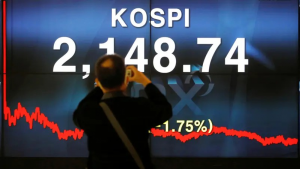Future Market Insights Global & Consulting Pvt. Ltd.
North America is expected to grow at the highest level during the forecast period. Aviation industries are adopting sustainable aviation fuels, hybrid-electric and all-electric aircraft, and renewable jet fuels
NEWARK, Dell, July 25, 2022 (Globe Newswire) — The global sustainable aviation fuel market will reach an estimated value of US$220 million in 2030, growing from a value of US$220 million in 2021. The market is expected to exhibit a tremendous CAGR of 60% in the forecast period of 2022-2032. In use since 2008, sustainable aviation fuel (SAF) is derived from biomass and organic waste resources. Advances in technologies have enabled SAF to be used in all types of petroleum-based fuel engines. This will augur well for the sustainable aviation fuel market by opening up new market opportunities.
Due to its production from renewable sources as well as increased aero-engine efficiency by design modification, SAF is anticipated to gain traction as a sustainable alternative fuel in the coming years. The focus on carbon footprint reduction to secure a sustainable environment coupled with the implementation of stringent rules and regulations by governments around the world is helping drive the growth of the sustainable aviation fuel market.
request a sample PDF, /reports/sample/representative-GB-14269
ALSO READ: China shuts down iPhone maker, CNOOC in Shenzhen to fight Covid Mercado Bitcoin plans to expand to Mexico Increase in disposable income, increase in the number of airline passengers, increase in air travel, and increase in use of synthetic lubricants are factors that contribute to the growth of sustainable aviation fuel market. The use of sustainable aviation fuels is widely accepted as the most viable and reliable alternative fuel solution in terms of socio-economic benefits. Sustainable aviation fuel also reduces the current and future impact of the aviation industry on the environment. All these factors are expected to boost the market for sustainable aviation fuel.
“The absence of suitable alternative propeller technology along with the adoption of low carbon technologies in the aviation industry will drive the growth of sustainable aviation fuel sales in the market over the forecast period,” An FMI Analyst Says,
story continues
key takeaways:
The drive for reduction in carbon footprint will fuel the growth of the market over the forecast period.
The improved efficiency of sustainable aviation fuels will complement the market growth in the assessment period.
Market strategies such as agreements and contracts to offer lucrative opportunities.
The North America market will show the fastest CAGR during 2022-2032.
Sustainable aviation fuel projects and initiatives undertaken by Canada and the US will contribute to the growth of the market.
The biofuel segment of sustainable aviation fuel will lead the market over the forecast period.
The 30%-50% biofuel blending capacity segment is expected to outperform others in the forecast period.
Request Brochure @ /Reports/Brochures/Representational-GB-14269
competitive landscape
Neste (Finland), Fulcrum BioEnergy (US), LanzaTech (US), World Energy (US), and TotalEnergy (US) are some of the other leading organizations working in the sustainable aviation fuel market. Apart from these key organisations, some of the start-up companies included in the full version of the report are PREEM (Sweden), OMV (Austria), Atmosphere (Germany), Westfuel (US), Prometheus Fuels (US), Red Rocks (US), and Red Rocks (US). Biofuels (US), Northwest Advanced Biofuels (US).
Major players in the sustainable aviation fuel market are engaged in expanding their product portfolio to include biofuels, synthetic fuels, efuels, green fuels and hydrogen fuels, along with enhancing their products and services. These organizations also adopt market expansion strategies like mergers and acquisitions to gain a competitive edge.
more insight into sustainable aviation fuel market report
In its latest report, FMI provides an unbiased analysis of the global sustainable aviation fuel market, providing historical data from 2017 to 2021 and forecast data for the period 2022 to 2032. To understand the global market potential, growth and range, the market is Platform (Commercial Aviation, Military Aviation, Business and General Aviation, Unmanned Aerial Vehicles), Biofuel Blending Efficiency (below 30%, 30% to 50%, 50 % above), segmented GNSS by type (total stations, global navigation satellite system), laser scanners, sensors, others), biofuel manufacturing technology (hydroprocessed fatty acid esters and fatty acid-synthetic paraffinic kerosene (HEFA-SPK) ), Fischer Tropes synthetic paraffinic kerosene (FT-SPK), fermented hydroprocessed to synthetic iso-paraffin sugar (HFS-SIP), alcohol to jet SPK (ATJ-SPK), catalytic hydrothermolysis jet (CHJ), fuel type (biofuel , hydrogen fuel, liquid fuel power, gas to liquid fuel) and field.
Ask an Analyst @ /ask-question/rep-gb-14269
sustainable aviation fuel Market Sector Analysis
According to the latest FMI report, North America is expected to lead the global sustainable aviation fuel market in terms of growth and expansion. North America’s sustainable aviation fuel market is projected to grow at the fastest CAGR. The United States and Canada are undertaking various sustainable aviation fuel projects and initiatives such as the Commercial Aviation Alternative Fuels Initiative (CAAFI), the Midwest Aviation Sustainable Biofuels Initiative (MASBI) and Canada’s Biojet Supply Chain Initiative. These countries are using renewable aviation fuel programs and initiatives to meet the need for a lower carbon footprint arising from increasing air traffic.
In addition, ancillary legislation and large-scale measures adopted to reduce aviation fuels in the US create the most viable market environment for sustainable aviation fuels.
The biofuel segment is the largest sustainable aviation fuel market by fuel type, due to its application in commercial and technological routes as an alternative to jet fuel. The Netherlands, Norway and the UK are some of the biggest investors in this segment.
In terms of biofuel blending efficiency, the 30% to 50% category performs better than any other category in this segment. Moderate blending capacity, drop-in facility in existing fuel systems and supply logistics infrastructure are driving the growth of this market segment.
Talk to our research expert@ /ask-question/rep-gb-14269
major section
By Platform:
Biofuels by Blending Efficiency:
below 30%
30% to 50%
above 50%
by type:
Biofuel manufacturing technology by:
Hydroprocessed fatty acid esters and fatty acids – synthetic paraffinic kerosene (HEFA-
Fisher Tropes Synthetic Paraffinic Kerosene (FT-SPK)
Synthetic iso-paraffin from fermented hydroprocessed sugar (HFS-SIP)
Wine to Jet SPK (ATJ-SPK)
Catalytic Hydrothermolysis Jet (CHJ)
By type of fuel:
biofuel
hydrogen fuel
liquid fuel power
gas-to-liquid
buy now@ /checkout/14269
About FMI – Oil & Gas
FMI’s Oil & Gas team presents an exclusive, dedicated and factual analysis of the global oil and gas industry. This extensive research ranges from commodity, wholesale, specialty, retailing and distribution channels to advanced materials, composites, with a special emphasis on ‘green alternatives, recycling and renewable technology development, supply-demand-business evaluation, and relevant advancements’ . industry. Our research studies work within the context of market guidelines for developing oil and gas manufacturers, channel partners and government bodies – ‘The Way Forward’.
table of content 1. Executive Summary
1.1. Global Market Outlook
1.2. summary of statistics
1.3. Key features and characteristics of the market
1.4. FMI Analysis and Recommendations
2. Market Overview
2.1. market coverage
2.2. market definition
3. Market Risk and Trend Assessment
3.1. risk assessment
3.1.1. COVID-19 crisis and impact on sustainable aviation fuel
3.1.2. COVID-19 impact benchmark with past crisis
3.1.3. Impact on Market Price (US$ Mn)
3.1.4. Ratings by Major Countries
3.1.5. Valuation by Major Market Segments
3.1.6. Action points and recommendations for suppliers
3.2. Major trends affecting the market
3.3. Formulation and Product Development Trends
4. Market Background
4.1. Sustainable Aviation Fuel Market by Major Countries
4.2. Sustainable Aviation Fuel Market Opportunity Assessment (US$ Mn)
4.2.1. total market available
4.2.2 Serviceable Addressable Markets
4.2.3. serviceable receivables market
TOC continues..!
have a look at oil and gas Domain Related Research Reports:
Digital Oilfield Solutions Market Size: Sales in the global Digital Oilfield Solutions Market is expected to reach US$37.2 Bn in 2022. Expanding at a healthy 6.5% CAGR, the market size is projected to total US$54.4 billion by 2028.
Floating Power Plant Market Trends: The global floating power plant market size is expected to be US$10.5 billion in 2022. It is projected to reach US$17.3 billion in 2032 and exhibits an astonishing CAGR growth of 11.4% over the forecast. The period from 2022 to 2032.
Fuel Cell Market Outlook: The global fuel cell market is gaining strength and is predicted to grow at an impressive CAGR of 25.2% during 2022-2032.
Energy Harvesting Market Forecast: The Global Energy Harvesting Market is projected to record a CAGR of 7.5% by 2022-2032.
Micro Inverter Market Share: The global micro inverter market size touched a valuation of US$1.59 billion in 2021 and is expected to reach US$3 billion by 2028.
Gas Engine Market Demand: The global gas engine market size touched a valuation of US$ 4.8 billion in 2022 and is projected to expand at a moderate CAGR of 4.1% during the forecast period between 2022 and 2032.
No. 2 Diesel Fuel Market Analysis: The global No. 2 Diesel Fuel market is expected to exhibit a growth of 1% – 4% at a CAGR of 1% during the forecast period 2022 – 2032.
Generator Sales Market Overview: The global generator sales market size was US$ 21.6 Bn in 2022 and is projected to reach US$ 28.6 Bn by 2027, exhibiting a CAGR of 5.8% over the forecast period (2022-2032).
Portable Power Station Market Share : Portable Power Station Market is projected to witness a growth of 7% to 8% in the forecast period 2021 -2032
About Future Market Insights (FMI)
Future Market Insights (ESOMAR certified market research organization and member of the Greater New York Chamber of Commerce) provides in-depth insights into controlling the factors driving demand in the market. It reveals the opportunities that will favor the growth of the market over the next 10 years across various sectors based on source, application, sales channel and end use.











